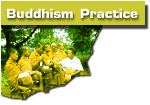 |
BANGKOK
|
||||||||
CENTRAL
|
||||||||||||
NORTHEASTERN
|
||||||||||||||
NORTHERN
|
||||||||||||
SOUTHERN
|
||||
 |
| A GUIDE TO MEDITATION CENTRES IN THAILAND |
| CENTRAL - BOONKANJANARAM MEDITATION CENTER |
MEANING
OF NAME : |
"Boon" Charoenchai and his wife "Kanjana" donated the land in 1963 for an aram (wat). |
ADDRESS
: |
Pattaya, Chonburi 20260 |
DIRECTIONS
: |
Located in Jomtien Beach, 5 km south of Pattaya. From Bangkok, take a bus from the Eastern (Ekamai) Bus Terminal to Sattahip and get off at Wat Boonkan janaram, just past KM post 150, then walk down Wat Boon Road alongside the wat; entrance to the meditation center is a short way beyond the wat grounds. If you take a bus to Pattaya, hire a song taew to the center. |
TELEPHONE
: |
0-3823-1865 |
MEDITATION
SYSTEM : |
Vipassana, based on the Four Foundations of Mindfulness using techniques taught by Ajahn Naeb. Unlike other vipassana systems that begin with mindfulness of breathing, the method taught here proceeds directly to mindfulness of the Four Foundations (satipatthana ) body (kaya ), feeling ( vedana ), mind ( citta ), or mind object ( dhamma ). The body ( kaya ) makes the best object to start with for nearly all people because of its gross, easily observed qualities. The meditator applies steady mindfulness to his body in the 4 basic positions of sitting, standing, walking, and lying and in the minor positions. The purpose of the meditation is to destroy wrong views about self, eliminate liking and disliking, realize the Four Noble Truths, and end suffering. When pain is noticed, the position is changed and the pain is followed into the next position. As practice becomes more proficient, the Three Characteristics of impermanence (anicca ), suffering ( dukkha ), and not self ( anatta ) will become more evident. Rupa and nama (material and mental factors) are seen as impermanent because they cannot stay the same. Rupa and nama are seen as suffering because the position is suffering. Rupa and nama are seen as not self, because whatever is impermanent and suffering is without self. As practice deepens it is seen with insight that rupa and nama are not self, not "me." This wisdom can have a very strong effect. When the Three Characteristics are seen in rupa and nama, wisdom is going to feel disenchantment with rupa and nama. This is the path to realize nibbana according to the meditation system. Before one begins practice, one must understand some theory. This requires more study than most meditation techniques. The meditation system taught her also has a reputation for being more difficult than breathing-based systems. |
TEACHING
METHOD : |
Interviews with teacher.A single beginning student would be taught alone; if more than one beginner is at the center, they would be grouped together. Beginners usually have daily interviews at first, then less often as determined by the teacher. Although instructions are in book form, it is considered valuable to have a "good friend" or teacher. |
TEACHERS
: |
Mr. Chua Jantrupon (Thai; age 86) assisted by Miss Vitoon Voravises (translator) and Frank Tullius (a longtime American practitioner at the center). |
LANGUAGE
: |
English translation is available (the teacher does not speak much English). Frank Tullius also can provide instruction and advice. The book Vipassana Bhavana , published by the center, has detailed information on theory, practice, and result of the meditation system used here; the book is sold at the center (by mail order too) and at some bookstores in Bangkok and Chiang Mai; a French edition is available at the center. |
DESCRIPTION
: |
The meditation center covers 22 rai (8.5 acres) in an old coconut grove with grass, bamboo, and a variety of trees. Facilities include 51 kutis, a small temple, a dining area for monks, and a kitchen. The center operates independently from nearby Wat Boonkanjanaram for the most part. |
SIZE
: |
monks
5-15 novices occasionally a few nuns 5-15 laypeople 4-8 |
DAILY
ROUTINE : |
None, except for meals and interviews. Practice schedule is left up to meditator. |
FOOD
: |
Good quality and variety; vegetarian is available on request. Food is brought to kutis at 7 a.m., 11 a.m., and 5 p.m. (people on 8 or more precepts just take the morning meals); an afternoon drink is offered too. Monks and novices go on pindabat. Normally everyone eats mindfully at their kuti; monks and novices sometimes eat as a group when food is specially offered. |
ACCOMMODATIONS
: |
Individual kutis with screens, fans, electricity, porches, and Thai-style bathrooms (some have western-style toilets) with running water. Moderately well spaced. |
WRITE
IN ADVANCE? : |
Yes, needed in order to arrange accommodations. |
OTHER
INFORMATION : |
Ajaan
Naeb (1897-1983), a Thai laywoman, had a deep experience of no self
at the age of 34. She then sought out someone who could teach her vipassana-kammathana. She practiced under the Burmese monk
Pathunta U Vilasa and realized nibbana. She then turned her attention
to study of abhidhamma and became an expert on Buddhist philosophy.
For 40 years she taught vipassana at many centers, including Boonkanjanaram. No group practice is offered. Meditators must be highly self-reliant and motivated to practice successfully. They are advised to keep noble silence with each other and abstain from reading (other than about practice) and listening to the radio. Two weeks is the recommended minimum stay. Six other centers in Thailand teach the same meditation system, though usually only in Thai. A 50 baht (US $2) daily charge is made for running expenses. |
| Select here : |
|
|